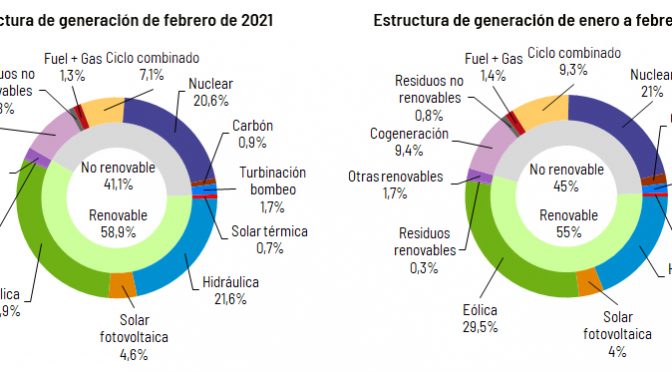Photovoltaics generated 4.6% and concentrated solar power 0.7%. So far in 2021, wind power produced 29.5% of electricity in Spain.
The demand for electricity in Spain fell by 3.5% in February. Taking into account that February 2020 had one more day as it was a leap year, in addition to other effects related to the calendar and temperatures, the demand registers a 5.2% decrease compared to the same month of the previous year.
Except for February 4, the Spanish electricity system closed every day with a balance of renewable production greater than polluting generation, which has made it possible for 58.9% of the national production of the month to be of renewable origin.
The demand for electrical energy decreased by 10.4% in the Balearic Islands and 17.2% in the Canary Islands compared to February 2020.
The national electricity demand for this month is estimated at 20,254 GWh, 3.5% lower than that registered in February 2020, a month that had one more day as it was a leap year. If these and other effects of the calendar and temperatures are taken into account, the figure is 5.2% lower than in February of the previous year.
In the first two months of 2021, demand is estimated at 44,114 GWh, 1.5% less than in 2020. Again, once the influence of the calendar and temperatures has been corrected, the demand is 2.5% lower to that registered in the previous year.
In February, and according to data estimated to date, generation from renewable energy sources represented 58.9% of production, 43.3% more than the same period in 2020. Except for one day, on February 4, when renewables produced 44.5% of the total, throughout the month more than half of the daily production had its origin in renewable technologies and even reached shares of up to 68.4% of the total ( February 1 and 20).
Furthermore, in February, 81.2% of electricity production came from technologies that do not emit CO2 equivalent. With the information available today, the generation of wind origin for the month of February reached 6,346 GWh, a figure 48.6% higher than that registered in the same period last year, and accounted for 29.9% of production , being the first technology of the national generation mix, ahead of hydraulic (21.6%) and nuclear (20.6%).
National_Generation
The demand for electrical energy falls by 2.8% in the peninsular electrical system
In the peninsular electricity system, the demand for this month is estimated at 19,276 GWh, 2.8% lower than that registered in February 2020, which had one more day as it was a leap. If these and other effects of the calendar and temperatures are taken into account, the demand is 4.6% lower than that of the same month of the previous year.
In the first two months of 2021, the demand for electricity in the Peninsula is estimated at 41,982 GWh, a
1% less than in 2020. In this case, once the influence of the calendar and temperatures has been corrected, the demand is 2% lower than that registered in the same period of the previous year.
During this month and according to data estimated today, 60.9% of the peninsular generation was of renewable origin and 84.1% came from technologies that do not emit CO2 equivalent. For its part, wind power registered 6,286 GWh, 50.5% higher than in February last year, and became the first source of generation by contributing 30.9% to the mix.
The demand for electricity decreased by 10.4% in the Balearic Islands and 17.2% in the Canary Islands in February
In the Balearic Islands, the demand for electricity this month is estimated at 361,279 MWh, 10.4% lower than that registered in February 2020, a month that had 29 days as it was a leap year. If these and other effects of the calendar and temperatures are taken into account, the figure drops 10.9% compared to February 2020. In the first two months of this 2021, Balearic demand is estimated in gross terms at 832,000 MWh, 3.2% less than in the same period of 2020.
The combined cycle, with 77.2% of the energy produced in the Balearic Islands, was the archipelago’s first source of electricity generation in February, the month in which renewable energy and that do not emit CO2 equivalent generated in the Balearic community represents 7 9% of the total. In addition, during this month the electrical energy from the submarine link between the Peninsula and Mallorca covered 31.4% of the Balearic electricity demand.
For its part, in the Canary archipelago the demand for electricity is estimated at 584,289 MWh, 17.2% lower than that registered in February of last year. If one takes into account that 2020 was a leap year, in addition to other effects of the calendar and temperatures, the figure drops 17.4% compared to the same month last year. In the first two months of 2021, Canarian demand is estimated in gross terms at 1,231,483 MWh, 15.8% less than in the same period of the previous year.
In the Canary Islands, also the combined cycle, with 47.9% of the total, was the first source of electricity generation in February. Renewables and emission-free technologies represented 13.6% of production.


